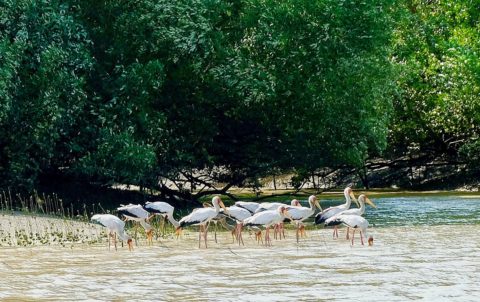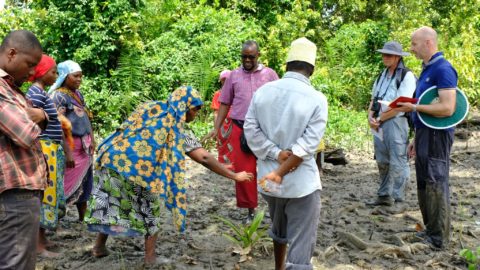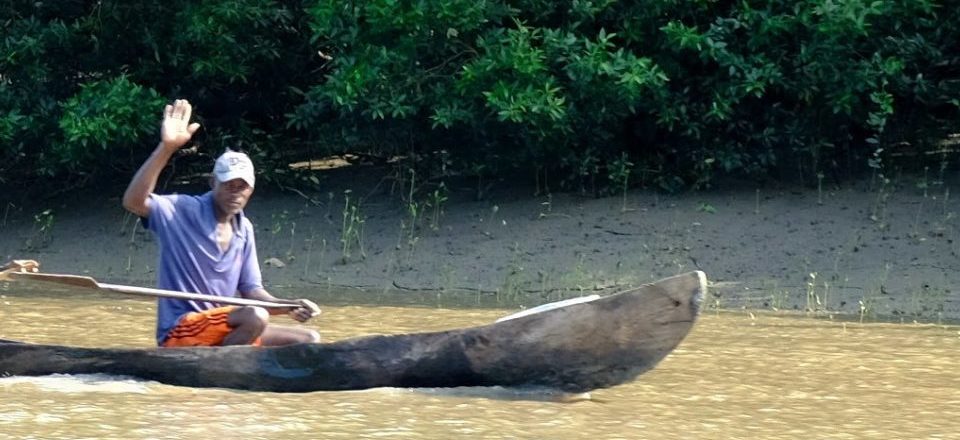Mangrove restoration is not just planting one or two mangrove species in straight lines – it’s much more complex than that. To demystify this, together with Mangrove Action Project (MAP), Wetlands International undertook a Community-Based Ecological Mangrove Restoration (CBEMR) training for 28 participants in Kibiti, Rufiji Delta, Tanzania. All too frequently, restoration projects move straight into building a mangrove nursery and planting before understanding the issues related to the project site. These projects often fail.
CBEMR supports a holistic, science-based approach that encourages practitioners to mitigate mangrove stressors and facilitate natural mangrove regeneration. This is achieved by working with the local communities to understand all social and technical challenges affecting the restoration site, including site hydrology, soil elevation relative to sea level, pressures on the mangroves and why a site is not naturally regenerating. CBEMR avoids the costs and necessity of building a nursery and planting, as natural regeneration encourages all the species in the locality to find their appropriate sites. CBEMR is an adaptable process, allowing mangrove workers to take on all sorts of different challenges, such as very high salinity in the Saloum Delta, Senegal; grazing pressure in Rakhine State, Myanmar; or encroachment for rice farming within the Rufiji Delta.

The mangrove ecosystem in the Rufiji delta provides a bountiful living space for many iconic species, ranging from fish, migratory water birds, sea turtles nesting on beaches secured by mangrove roots, crabs and shrimp that thrive in mangrove shallows, and wildlife. However, despite the huge value of mangroves in the Rufiji delta, they are being heavily exploited and degraded. To address these challenges, the CBEMR training was organised in two phases, a five-day, more theoretical workshop (28th Jan – 2nd Feb, 2019) followed by three days of more practical training (3rd – 5th Feb) as a follow-up to the classroom workshop. Jim Enright, Dominic Wodehouse and Jaruwan ‘Ning’ Enright from MAP were the trainers. The participants were carefully selected by Wetlands International Eastern Africa from the mangrove forest community leaders living in the delta, the government’s Tanzania Forest Service, local NGOs and community-based organisations, as well as representatives from Kenya, Mozambique and Madagascar. This training was timely as this year’s World Wetlands Day theme ‘wetlands and climate change’ highlighted the critical role mangroves play as carbon sinks and the protective role they play protecting communities from floods, storms and adverse climatic conditions.
Speaking during the training, the district commissioner for the Kibiti region, Mr Mr.Gulamhussein Kifu, urged participants to work together to sustainably conserve the mangroves. He called on the trainers to share alternative livelihood options with communities living in and depending on this vital resource that would encourage wise use of mangroves and raise awareness of the mangrove values.
The training focused on two elements. First, the trainers explained the features of mangrove biology and ecology that were relevant to the CBEMR approach to mangrove rehabilitation. This helped increase participants’ ability to understand the complexities of potential sites – social as well as biophysical – and how they can rehabilitate them using the CBEMR method. This included mitigating mangrove stressors and understanding why mangroves were not regenerating, before facilitating natural regeneration and monitoring the work for 3-5 years. Beyond the problem of clearance for rice farming in the delta, the mangroves suffer from over-harvesting of mangroves poles and timber and smothering by climbers which stress big trees and kill off juvenile plants and natural regeneration. Second, the group focused specifically on the issue of encroachment by rice farmers in the western end of the delta. Rice farming within this part of the delta was possible because the salinity of the water was so low, which also encouraged the mangroves to grow rapidly. The combined group explored what conditions and resources the government would have to provide to stop any further encroachment, incentivise the farmers to restore the land they had cleared of mangroves, and eventually encourage the farmers to move inland to farm in more appropriate areas. Discussions included the need to offer alternative livelihood options that would reduce the mangrove clearance. To encourage discussion of this option, MAP presented case studies from Thailand documenting community honey production in mangrove-based villages. Representatives from different countries who attended the training also shared lessons learned from their own projects, successes and challenges.
Pictorial from the CBEMR training

Mangrove Capital Africa is a 10-year programme whose vision is: Mangroves and their biodiversity are healthy, improving the livelihoods of millions of people and protecting them against the dangers of climate change. So far, the programme has conducted several baseline studies in the delta in order to understand the status of the delta and the different issues related to mangrove restoration. “Through this training, we will raise awareness on when to plant and when not to plant, while at the same time highlighting the issues affecting Rufiji mangroves, as well as how they can better more effectively conserved,” said Mr. Ismail Saidi project manager.
The programme is led by Wetlands International and funded by DOB ecology

